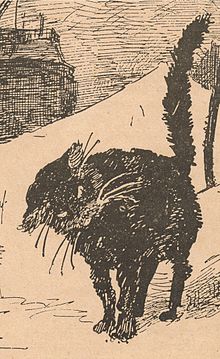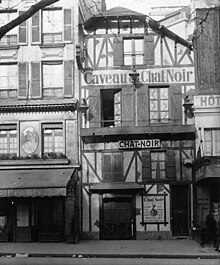Le Chat Noir is thought to be the first modern cabaret:[ a nightclub where the patrons sat at tables and drank alcoholic beverages while being entertained by a variety show on stage. The acts were introduced by a master of ceremonies who interacted with well-known patrons at the tables. Its imitators have included cabarets from St. Petersburg (Stray Dog Café) to Barcelona (Els Quatre Gats).
Perhaps best known now by its iconic Théophile Steinlen poster art, in its heyday it was a bustling nightclub that was part artist salon, part rowdy music hall. From 1892 to 1895 the cabaret published a weekly magazine with the same name, featuring literary writings, news from the cabaret and Montmartre, poetry, and political satire.
The cabaret began by renting the cheapest accommodations it could find, a small two-room site located at 84 Boulevard Rochechouart, (now commemorated only by a historical plaque). Its success was assured with the wholesale arrival of a group of radical young writers and artists called Les Hydropathes ("those who are afraid of water – so they drink only wine"), a club led by the journalist Émile Goudeau. The group claimed to be averse to water, preferring wine and beer. Their name doubled as a nod to the "rabid" zeal with which they advocated their sociopolitical and aesthetic agendas. Goudeau’s club met in his house on the Rive Gauche (left bank), but had become so popular that it outgrew its meeting place. Salis met Goudeau, whom he convinced to relocate the club meeting place across the river on rue de Laval (now rue Victor-Massé).
Second site
Le Chat Noir soon outgrew its first site. In June 1885, three and a half years after opening, it moved to larger accommodations at 12 Rue Victor-Massé. The new venue was the sumptuous old private mansion of the painter Alfred Stevens, who, at Salis' request, transformed it into a "fashionable country inn" with the help of the architect Maurice Isabey. On 10 June 1885, with great fanfare, Salis moved to new premises at 12 Rue Victor-Massé.
Soon, a growing crowd of poets and singers gathered at Le Chat Noir, which offered an ideal venue and opportunity to practice their acts before fellow performers, guests and colleagues.
With exaggerated, ironic politeness, Salis most often played the role of conférencier (post-performance lecturer, or master of ceremonies). It was here that the Salon des Arts Incohérents (Salon of Incoherent Arts), shadow plays, and comic monologues got their start.
Famous men and women to patronize the Chat Noir included Jane Avril, Franc-Nohain, Adolphe Willette, Caran d'Ache, André Gill, Émile Cohl, Paul Bilhaud, Sarah England, Paul Verlaine, Henri Rivière, Claude Debussy, Erik Satie, Charles Cros, Jules Laforgue, Yvette Guilbert, Charles Moréas, Albert Samain, Louis Le Cardonnel, Coquelin Cadet, Emile Goudeau, Alphonse Allais, Maurice Rollinat, Maurice Donnay, Armand Masson, Aristide Bruant, Théodore Botrel, Paul Signac, Porfirio Pires, August Strindberg, George Auriol, Marie Krysinska, and Henri de Toulouse-Lautrec.
The last shadow play by Salis's company was staged in January 1897, after which Salis took the company on tour. Salis was talking of plans to move the cabaret to a location in Paris itself, but he died on 19 March 1897.
The death of Rodophe Salis in 1897 spelled the end of the Chat Noir. By that time, the fascination for Montmartre had already diminished, and Salis had already disposed of many of the club’s assets and facilities. Soon after Salis’ death, the artists dispersed, and Le Chat Noir slowly disappeared.
Last location
Ten years later, in 1907, Jehan Chargot opened an eponymous café in an effort to resurrect, modernize, and continue the work of his illustrious predecessor. This new Chat Noir, located at 68, boulevard de Clichy, remained popular into the 1920s.
Today, a neon sign which incorporates Steinlen’s iconic Chat Noir image is on display at 68, Boulevard de Clichy, now the site of a hotel by the same name.
Other cabarets successfully copied and adapted the model established by the Chat Noir. In December 1899, Henri Fursy opened his Boîte à Fursy cabaret in the former Chat Noir hôtel on rue Victor-Massé. He claimed to have inherited the mantle of Salis, and said his cabaret "has thanks to Fursy become once again the goal of all who 'climb Montmartre' to hear their favorite chansonniers..."
Shadow play
Under the management of Rodolphe Salis, Le Chat noir produced 45 théatre d'ombres (shadow play) shows between 1885 and 1896, as the art became more popular in Europe. Behind a screen on the second floor of the establishment, the artist Henri Rivière worked with up to 20 assistants in a large, oxy-hydrogen backlit performance area and used a double optical lantern to project backgrounds. Figures were originally cardboard cutouts, but zinc figures were used after 1887. Various artists took part in the creation, including Steinlen, Adolphe Willette and Albert Robida. Caran d'Ache designed around 50 cutouts for the very popular 1888 show L'Epopée.
Cultural associations]
A poster of "Le Chat Noir" may be seen prominently in the crime scene photographs from the 2001 murder of Kathleen Peterson by her husband and novelist Michael Peterson. Le Chat Noir is the name of the nightclub where Frank Sinatra and Natalie Wood rekindle their relationship, in the 1958 movie Kings Go Forth. There is also the famous cat painting with blinking eyes on the entrance wall.






No comments:
Post a Comment